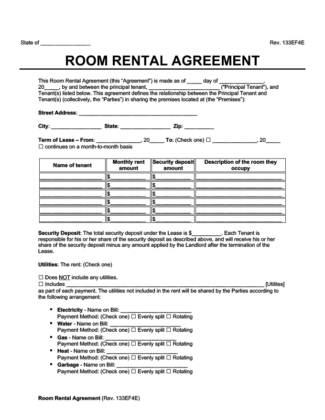
Use our Room Rental Agreement to rent out a room in your apartment or house.

Updated May 31, 2024
Written by Yassin Qanbar | Reviewed by Susan Chai, Esq.
A room rental agreement is a legally binding contract between a tenant and a sub-tenant, the person the original tenant wants to rent a room to.
This document clearly outlines the expectations and responsibilities of both parties, the original and sub-renter. Upon execution, this agreement imposes specific duties and obligations on both parties.
If you are a principal tenant who wishes to sublease your entire rental, use our Sublease Agreement form instead.
A room rental agreement incorporates elements and terms of the original lease agreement and serves as a detailed and comprehensive guide for tenant responsibilities and rights.
A room rental agreement outlines the responsibilities of a principal tenant subleasing a room in a rental property, not the entire rental.
Unlike oral agreements, the law usually honors written agreements. These agreements carry more weight when a tenant needs to enforce financial responsibilities and obligations on a sub-tenant.
Therefore, a room rental agreement is essential for protecting tenant rights when the principal tenant subleases a room in a property to secondary tenants.
A simple room rental agreement will identify the following elements:
At first glance, there does not seem to be much difference between a room rental agreement and a roommate agreement. However, there are several notable differences you should acquaint yourself with.
When entering a housing arrangement, make sure you know the differences between the two. Otherwise, you could open yourself and your fellow tenants up to vague and undefined expectations and obligations.
| Type | Room Rental Agreement | Roommate Agreement |
|---|---|---|
| Other Names | Also known as a “sublease” | Referred to as a ‘housemate agreement,” or “roommate contract” |
| Purpose | Used when a tenant wants to sublet their room to a third party | Used when moving in with a new roommate, or have found a new roommate |
| Does It Need Approval? | Usually need landlord’s approval of the sublease | Doesn't usually need landlord’s permission |
| Lease Agreement Dependency | Incorporates elements of the original lease agreement | Independent of the original lease agreement |
| Parties Involved | Original tenant and subtenant | All roommates sharing the accommodation |
| Legal Standing | Subtenant has direct legal responsibilities to the original tenant | All roommates have legal responsibilities to each other |
| Financial Responsibility | Subtenant pays rent to the original tenant | Rent is usually split among all roommates and paid directly to the landlord |
| Security Deposit | May require a separate deposit from the subtenant | Usually no additional deposit beyond what is already required by the landlord |
You should use a room rental agreement when you are a homeowner, principal tenant, or building manager and want to lease a private room or portion of your property to a secondary tenant.
Use a room rental agreement to clarify both parties’ expectations, obligations, and responsibilities and promote a harmonious living environment.
Room rental agreements are a great tool to curb potential issues before they escalate and allow parties to open up communication channels.
When entering into a housing agreement, parties often overlook simple and obvious points of future contention, so think of a room rental agreement as a catalyst for starting certain difficult conversations early on.
Keep in mind that in the eyes of the law, room rental agreements are not all-encompassing.
Also, remember to do your due diligence when selecting a roommate, such as requesting a Landlord Recommendation Letter for a Tenant from previous landlords.
Although courts are more likely to enforce the financial responsibilities of both tenants, they will not order a delinquent tenant to vacuum the living room or wash the dishes.
Without a room rental agreement, you risk opening yourself and other tenants to severe financial consequences and wasted time, leading to serious headaches and stress or a potential lawsuit.
Below is a non-exhaustible list of the preventable suffering a room rental agreement could help prevent and resolve.
| Consequences | Common Situations |
|---|---|
| Lost Money | One party may end up stuck paying more rent, forfeiting a security deposit, or paying for damage to the property, because a party moved out early without notice. |
| Lost Time | If a roommate departs early, and without notice, you could be tasked with an unexpected search for a replacement roommate. Or, maybe you and your roommate have a disagreement over noise levels after midnight, without an agreement, you risk wasting time sorting these problems out at a later, inconvenient, date. Additionally, you don’t want to be cleaning up after your roommate hosts friends or a party, or from their general uncleanliness. |
| Lost Property | Without a room rental agreement, borrowed personal property could be damaged or never returned. Additionally, if community property is damaged during the course of tenancy, one party could be burdened with the bill. |
| Mental Anguish | Strained relationships are a common consequence of failing to outline a party’s rights and obligations under a contract. A landlord could distrust you due to your roommate’s behavior or lack of timely rental payments, or even a friendship with your roommate could deteriorate over small misunderstandings. |
Room rental agreements are effective tools for designating smoking areas and confirming whether or not alcohol is permitted on the premises.
Download a free room rental agreement in PDF or MS Word.
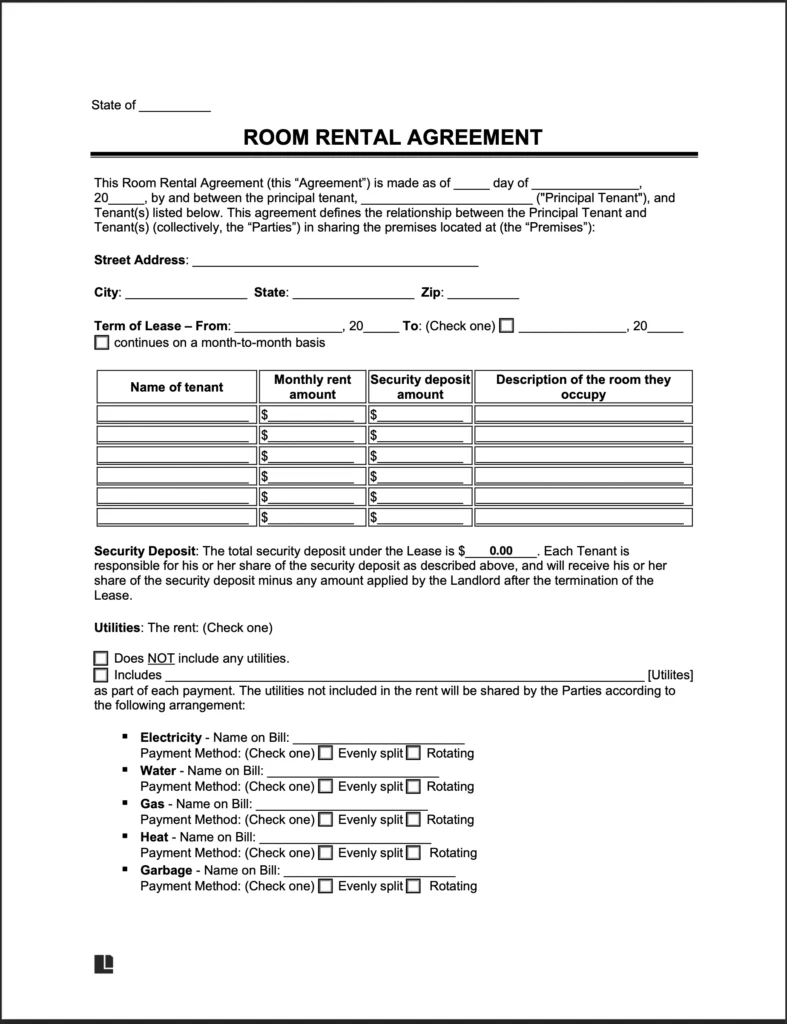
Before filling in the details of your room rental agreement, ensure the top of your form identifies the state you are contracting in.
In addition, be clear that this room rental form is between a principal tenant and a subtenant who wishes to rent a room, not an entire property. A different version of this form exists when a landlord wants to rent a room to a tenant.
1. Date of Agreement. Provide the effective date of this room rental agreement form.
2. Principal Tenant Name. Write the full name of the principal tenant (the person renting the room to the subtenant).

3. Property Address. Enter the street (physical) address of the room the tenant rents to the subtenant. Include any room, unit, or apartment number, if applicable.

4. Term or Length of Lease. Fill in the start date of the lease, and note either the lease’s end date (if it is a standard fixed-term lease) or that the lease continues on a month-to-month basis.
5. Tenant Name. Write the full name of the subtenant renting the room. Also, enter the monthly rent amount, security deposit amount (if any), and a description of the room rental (i.e., located on top of the garage with its bathroom).

6. Total Security Deposit. Provide the total amount of the security deposit for the property. This should be in the original lease agreement.

7. Utilities Included in Rent. State whether or not the rent includes any utilities. If yes, write a list of all utilities.
8. Utilities Not Included in Rent. For utilities not included in the rent, state whether or not the tenants will share the utility amounts. If tenants will share the utility amounts, provide the name of the person listed on the utility bill and how tenants will share the costs (evenly split, rotating, or another method).
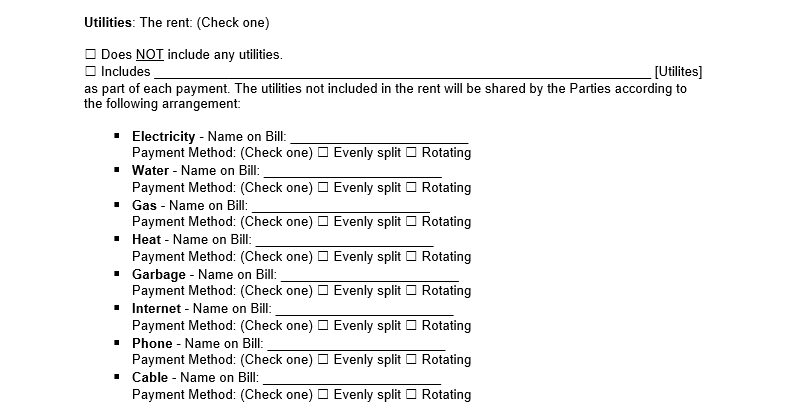
9. Parking Details. State whether or not the room rental includes parking privileges. If parking is included, provide the subtenant’s name, vehicle description, and parking spot.

10. Renter’s Insurance. State whether or not the subtenant needs to purchase renter’s insurance. If yes, provide the insurance company’s name, the insurance policy’s monthly rate, and the name of the signer(s) on the policy.
11. Early Termination. Write the months’ notice the tenant must give to terminate the room rental agreement.
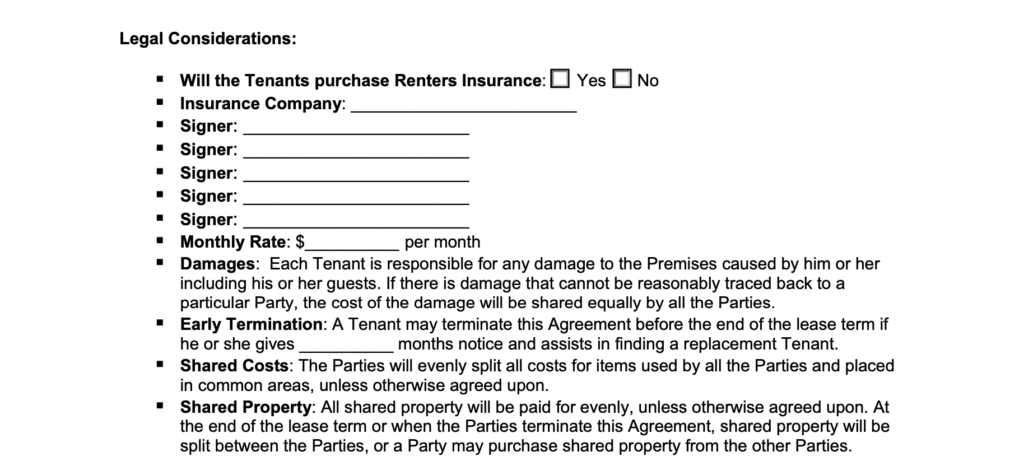
12. Pets. Specify whether or not the subtenant can have pets on the property. If the principal tenant allows pets, provide the pet’s name, type of pet, and the pet owner’s name.
13. Chores/Household Duties. Identify how often the tenants will discuss household duties.
14. Overnight Guests. State whether or not the subtenant can have overnight guests and if the subtenant must first discuss the guest with the principal tenant.
15. Noise Level/Quiet Hours. Write any quiet hours and the start and end times.
16. Parties/Entertaining. You can specify the maximum number of friends allowed over at a time. If a subtenant wants to invite more than the number specified here, state the number of days’ notice before the event the subtenant must discuss with the principal tenant. If a tenant wants to host a large gathering, note the number of days notice before the event the subtenant must consult with the principal tenant. Also, all tenants must agree to a large gathering.
17. Smoking and Alcohol Use. State whether or not the principal tenant allows smoking or alcohol on the property. If yes, specify specific smoking areas and hours when the subtenant can drink alcohol.

18. Governing Law. Identify the state’s laws that govern the construction of this room rental agreement.

Yes, a room rental agreement can cover multiple tenants. Be sure to include each tenant’s identifying information and the specified lease dates, as some tenants and roommates may differ.
You can execute room rental agreements week to week or month to month. When creating your document, make sure you specify the correct dates of the lease.
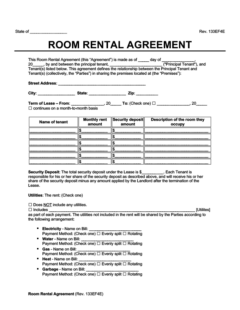
Create Your Room Rental Agreement in Minutes!